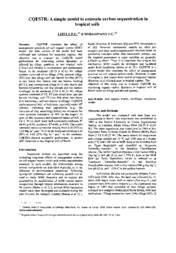CQESTR: a simple model to estimate carbon sequestration in tropical soils.
CQESTR: a simple model to estimate carbon sequestration in tropical soils.
Author(s): LEITE, L. F. C.; DORAISWAMY, P. C.
Summary: CQESTR simulates the effect of management practices on soil organic carbon (SOC) stocks. The beta version of the model had been calibrated and validated for temperate regions. Our objective was to evaluate the CQESTR model performance for simulating carbon dynamics as affected by tillage practices in two tropical soils (Ultisol and Oxisol) in southeastern and northeastern Brazil. In the southeast (20.75 S 42.81 W), tillage systems consisted of no tillage (NT); reduced tillage (RT) (one disc plough and one harrow leveling [RT1] or one heavy disc harrow and one harrow leveling [RT2]); and conventional tillage (CT) (two heavy disc harrows followed by one disc plough and two harrow levelings). In the northeast (7.55 S 45.23 W), tillage systems consisted of NT, RT (one chisel plow and one harrow leveling), and CT (one disk plow, two heavy disk harrowings, and two harrow levelings). CQESTR underestimated SOC at both sites, especially under NTsystems, indicating that adjustments (e.g., the inclusion of clay mineralogy factor) are necessary for more accurate simulation of SOC in the tropics. In spite of this, measured and simulated values of SOC in the 0?20 cm depth were well correlated (southeast, R2 =0.94, p<0.01; northeast, R2=0.88, p<0.05). The model estimated carbon emissions varying from 0.36 (NT) to 1.05 Mg ha-1 year-1 (CT) in the southeast and from 0.30 (NT) to 0.82 (CT) Mg ha-1 year-1 in the northeast. CQESTR showed acceptable performance to predict SOC dynamics in two tropical soils of Brazil.
Publication year: 2007
Types of publication: Paper in annals and proceedings
Unit: Embrapa Mid-North
Keywords: Matéria orgânica do solo, Solo Tropical
Observation
Some of Embrapa's publications are published as ePub files. To read them, use or download one of the following free software options to your computer or mobile device. Android: Google Play Books; IOS: iBooks; Windows and Linux: Calibre.
Access other publications
Access the Agricultural Research Database (BDPA) to consult Embrapa's full library collection and records.
Visit Embrapa Bookstore to purchase books and other publications sold by Embrapa.

